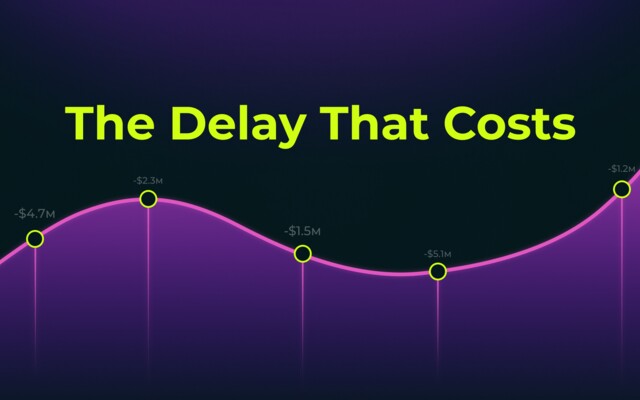Most brokers think of latency as a single number — a millisecond figure tied to execution speed or server distance. But real broker latency isn’t one number. It’s dozens of small timing gaps happening everywhere in the stack, often unnoticed, always expensive.
These gaps don’t show up in trade reports. They don’t trigger alerts. They rarely look like errors. But they quietly distort exposure, hedging, P&L symmetry, and even compliance posture.
Welcome to the world of hidden latency — the most underestimated cost center in modern brokerage operations.
The Latency Nobody Measures
Ask a CTO about latency, and they’ll tell you about execution speeds, price feeds, or server locations. Ask a risk manager, and you’ll hear about slippage, LP fills, and exposure drift.
But ask a COO what keeps them awake at night, and they’ll mention something harder to quantify:
“The time between something happening…and someone actually reacting to it.”
That’s the real latency brokers pay for — not network delay, but operational delay.
| Latency Type | Visible? | Impact |
|---|---|---|
| Execution latency | Yes | Measured, monitored, often optimized |
| Hedge latency | Partially | Exposure mismatch, LP cost inflation |
| Operational latency | No | P&L drift, rule misfires, compliance gaps |
The problem? Most losses come from the last one.
Where Latency Hides in a Broker's Day
Latency can hide in almost every operational function — not because teams are slow, but because technology and process don’t always move together.
Here are the five most common places it hides:
1. Hedge Execution Delay
Even a 2–10 second hedge delay during micro-trending markets can create mismatched fills, directional exposure, and cumulative drift.
2. Leverage Update Lag
Leverage rules that require human confirmation or run in batches turn small volatility bumps into real P&L events.
3. Swap-Free Reclassification Gaps
When swap-free windows expire but account states aren’t refreshed immediately, brokers get stuck with unintended overnight exposure.
4. Cross-Module Communication Lag
Margin alerts fire, but exposure systems update slower. Or hedging decisions depend on price feeds delayed by milliseconds — multiplied across thousands of trades.
5. Risk Alert Processing Latency
An alert is instant. A decision is not. Human escalations add seconds — and those seconds have a price.
None of these are “bugs.” They’re timing mismatches — and timing mismatches compound.
The Cost of Hidden Latency (With Real Numbers)
Let’s simulate a typical broker:
- 32,000 trades/day
- Major pairs, moderate volatility
- Hedging within 3–5 seconds on average
| Latency Source | Average Delay | Estimated Monthly Impact |
|---|---|---|
| Hedge mismatch | 2.8 sec | $35,000–$55,000 |
| Swap-free timing gaps | 30–50 min/day | $18,000–$40,000 |
| Delayed leverage updates | 1–3 sec/event | $12,000–$25,000 |
| Rule misalignment | Continuous | $20,000–$60,000+ |
Total possible hidden cost? $85,000 to $180,000 per month. And this doesn’t include opportunity cost (retention, LP relationships, audits).
Case Study: The 12-Pip Problem Nobody Saw Coming
A European broker once reported that everything “felt normal” for several weeks: retail flow, exposure, volatility — all smooth.
Then an audit revealed a consistent, tiny exposure bias on GBP pairs.
The cause? A 4–7 second hedging delay that only occurred during London–NY overlap. Why?
Because their bridge updated exposure every 20 seconds instead of continuously. That was enough to accumulate 12 pips of directional drift over the week.
No alerts fired. No rules triggered. Loss: $140,000.
Invisible, until it wasn’t.
Why Modern Flow Makes Latency More Expensive
Latency used to be a fair fight — brokers vs market. Now it’s brokers vs:
- smart execution bots,
- timed retail behavior,
- alert-sensitive flows,
- market-microstructure shifts,
- traders acting faster than risk teams.
Retail traders now have tools that professional desks used a decade ago. They don’t need to be malicious. They only need to be faster.
And every time they react faster than the broker’s risk layer, the broker pays.
The Difference Between Latency and Lag
Latency = time between event and action. Lag = time between action and correction.
Most brokers only measure lag — the effects. Modern brokers measure latency — the causes.
| Latency Insight | Operational Benefit |
|---|---|
| Hedge delay monitoring | Exposure symmetry, better LP fills |
| Trigger firing timestamps | Auditability + compliance defense |
| Swap-free timing control | Prevent unintended overnight exposure |
| Account behavior drift | Toxic flow early detection |
Latency isn’t one number — it’s the connective tissue of the broker’s risk stack.
How Leading Brokers Eliminate Hidden Latency
Top brokers now rely on three principles:
1. Continuous State Awareness
Systems that update exposure, margin, swap status, and triggers in near-real time — not in batches.
2. Reflex Rules
If-then logic that fires instantly and reversibly when conditions change, without waiting for approvals.
3. Timing Drift Detection
Algorithms that track the time delta between event → risk → hedge → confirmation.
The result? A book that doesn’t slowly tilt when nobody is watching.
Latency as the Broker’s New KPI
Five years ago, latency was a technical metric. Now it’s a financial one.
In 2026, the brokers who outperform the market won’t be the ones with the best spreads — they’ll be the ones with the most stable reaction time.
Because in the brokerage world, time isn’t just money.
Time is asymmetry. Asymmetry is risk. And risk, when delayed, becomes loss.

